October 28, 2016 at 4:21 pm
By Mark Latti
[caption id="attachment_2025" align="alignright" width="440"]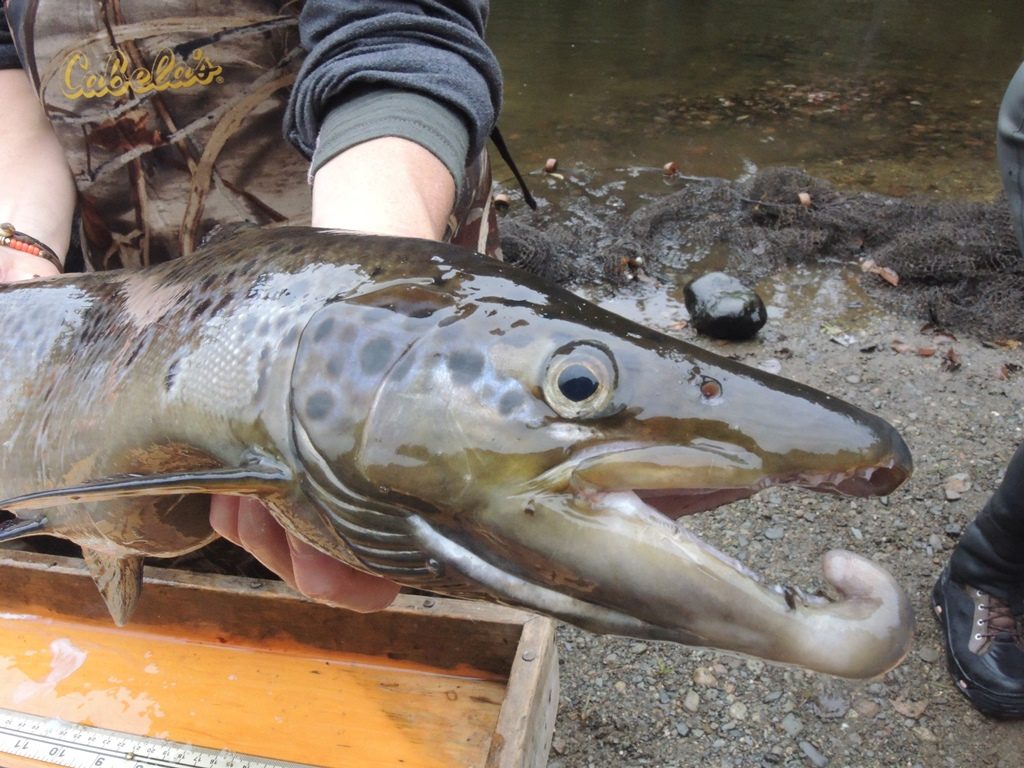 Male salmon develop a kype as they prepare to spawn.[/caption]
[caption id="attachment_2020" align="alignright" width="475"]
Male salmon develop a kype as they prepare to spawn.[/caption]
[caption id="attachment_2020" align="alignright" width="475"]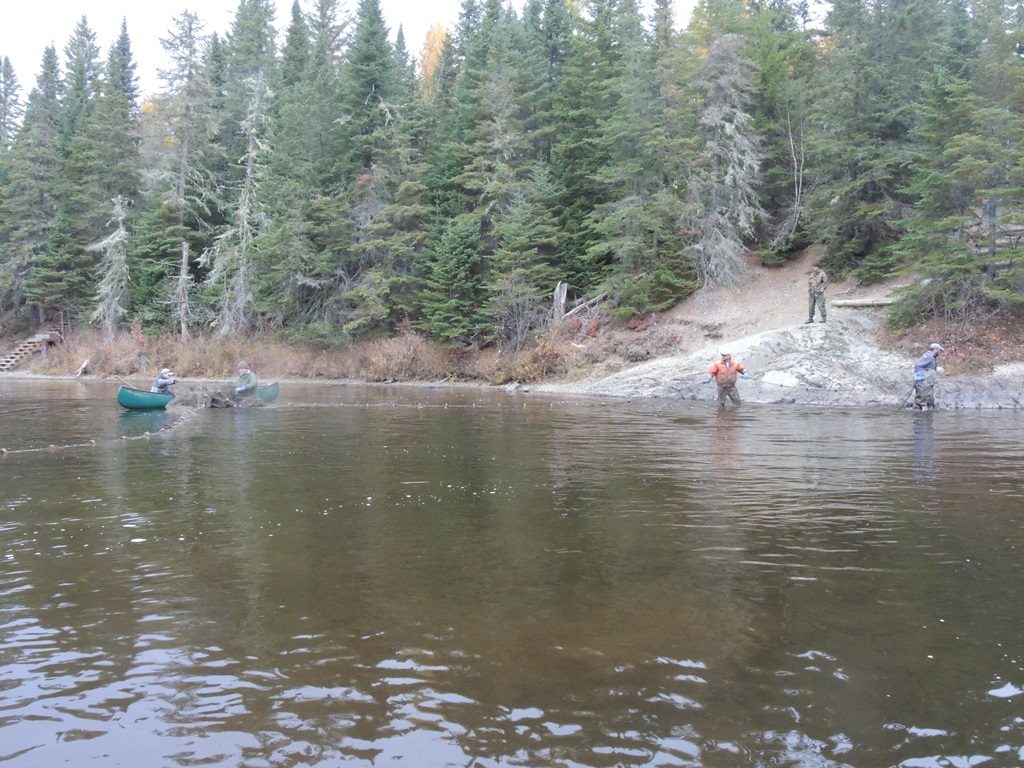 The net is stretched across the upriver side of steep bank pool.[/caption]
The Rangeley Region is synonymous with salmon and brook trout. Names of rivers such as the Rapid, the Magalloway and the Kennebago are instantly recognizable, and they are a welcome destination for anglers.
The Department of Inland
Fisheries and Wildlife keeps a close eye on fish populations in waterways throughout the state, including the Kennebago, which flows into Mooselookmeguntic Lake.
“The Kennebago River is the spawning area for salmon from Mooselook,” said IFW fisheries biologist Bobby Van Riper. “There is just a wealth of spawning habitat here.”
For years, the department has collected data on landlocked salmon in the Kennebago as they set to spawn.
“We evaluate the fishery each year to see if the numbers are changing, to see if there are increasing numbers of smaller fish, or more mature fish that are bigger and fatter,” said Van Riper.
In order to do this, biologists need to collect a significant number of salmon that is reflective of the population.
Steep Bank Pool on the Kennebago is well known to both anglers and salmon. The sharp 90 degree bend in the river has cut back the banks, leaving a deep hole where fish and anglers congregate.
[caption id="attachment_2021" align="alignright" width="482"]
The net is stretched across the upriver side of steep bank pool.[/caption]
The Rangeley Region is synonymous with salmon and brook trout. Names of rivers such as the Rapid, the Magalloway and the Kennebago are instantly recognizable, and they are a welcome destination for anglers.
The Department of Inland
Fisheries and Wildlife keeps a close eye on fish populations in waterways throughout the state, including the Kennebago, which flows into Mooselookmeguntic Lake.
“The Kennebago River is the spawning area for salmon from Mooselook,” said IFW fisheries biologist Bobby Van Riper. “There is just a wealth of spawning habitat here.”
For years, the department has collected data on landlocked salmon in the Kennebago as they set to spawn.
“We evaluate the fishery each year to see if the numbers are changing, to see if there are increasing numbers of smaller fish, or more mature fish that are bigger and fatter,” said Van Riper.
In order to do this, biologists need to collect a significant number of salmon that is reflective of the population.
Steep Bank Pool on the Kennebago is well known to both anglers and salmon. The sharp 90 degree bend in the river has cut back the banks, leaving a deep hole where fish and anglers congregate.
[caption id="attachment_2021" align="alignright" width="482"]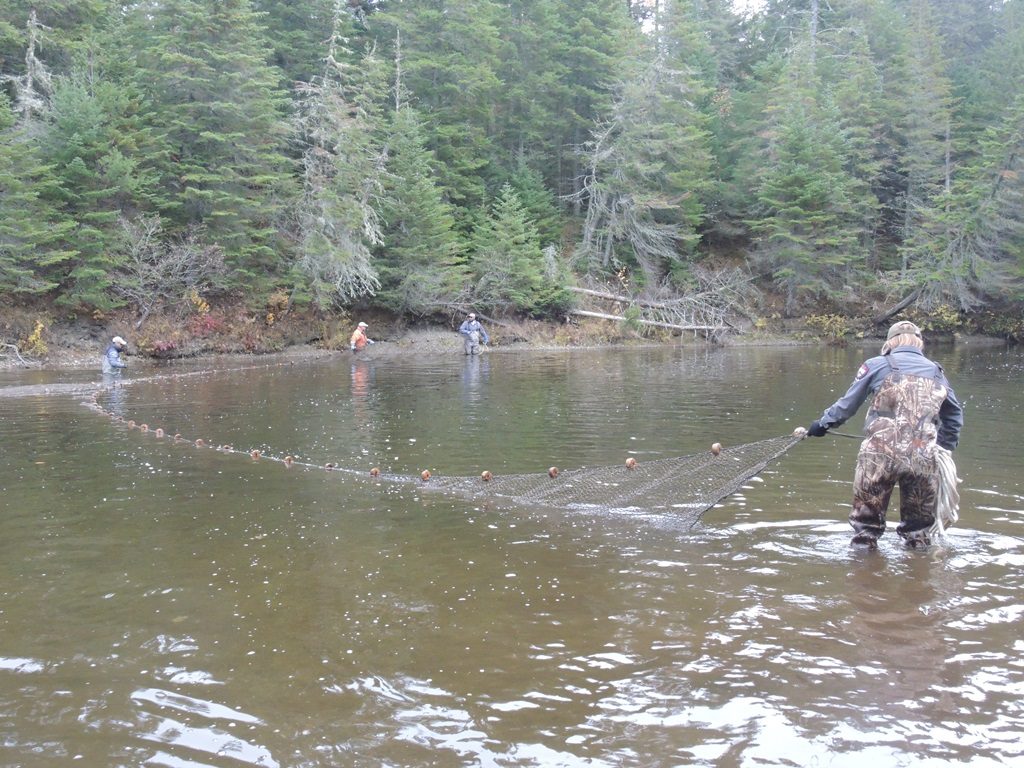 And then looped along the far bank of Steep Bank Pool.[/caption]
Using a long net as a seine, biologists encircle the pool with the net, closing off the escape routes at either end of the river. After encircling the pool, the net is tightened, and the fish are collected in the belly of the net.
The fish are then moved to holding nets in deeper water, and data collection begins. Working in teams at two different stations, on person retrieves the fish from the pens, one person measures length, weighs, and collects a scale, and another records the data. It’s a well-rehearsed routine that is designed to get as much biological data as possible in short period of time.
The data collected is analyzed over the winter. Viewing the scale under a microscope reveals a salmon’s age, and that, combined with the length and the weight, is a window into the health of a salmon.
“How many fish, how old, how fat, condition of the age classes, we break the data down and it tells what is going on here,” said Van Riper
Last week, close to 80 salmon were captured and examined. The largest was just a hair over five pounds and was 24 inches in length. There were multiple salmon in excess of three pounds. While a few had hooking injuries, the vast majority did not.
All of the salmon were native fish, which is somewhat of a pleasant problem to have. The department loves to see wild salmon populations thrive, but it does present a challenge to those who manage the fishery.
When salmon are raised at the hatchery and stocked, biologists can control how many fish are placed in a lake. If salmon look thin, they can reduce the number stocked to allow the salmon population to be more in balance with the available food. With the excellent reproductive rates of the salmon in the Kennebago River, there are a lot of salmon, but biologists would like to see that population diminished a bit.
“That high salmon population puts pressure on the smelt population,” said Van Riper. “Our hope is that some anglers will keep a few more fish, which will take some pressure of the smelt population and let the remaining fish get larger.”
Anglers on Mooselook are allowed to keep three salmon, with a minimum length limit of 12 inches, but only one over 16 inches. The regulation is designed to encourage the harvest of smaller salmon, but allow an angler to keep a trophy if they wish.
In the coming years, examining the biological data from the captured salmon at Steep Bank Pool will tell biologists if it is working.
[caption id="attachment_2022" align="aligncenter" width="520"]
And then looped along the far bank of Steep Bank Pool.[/caption]
Using a long net as a seine, biologists encircle the pool with the net, closing off the escape routes at either end of the river. After encircling the pool, the net is tightened, and the fish are collected in the belly of the net.
The fish are then moved to holding nets in deeper water, and data collection begins. Working in teams at two different stations, on person retrieves the fish from the pens, one person measures length, weighs, and collects a scale, and another records the data. It’s a well-rehearsed routine that is designed to get as much biological data as possible in short period of time.
The data collected is analyzed over the winter. Viewing the scale under a microscope reveals a salmon’s age, and that, combined with the length and the weight, is a window into the health of a salmon.
“How many fish, how old, how fat, condition of the age classes, we break the data down and it tells what is going on here,” said Van Riper
Last week, close to 80 salmon were captured and examined. The largest was just a hair over five pounds and was 24 inches in length. There were multiple salmon in excess of three pounds. While a few had hooking injuries, the vast majority did not.
All of the salmon were native fish, which is somewhat of a pleasant problem to have. The department loves to see wild salmon populations thrive, but it does present a challenge to those who manage the fishery.
When salmon are raised at the hatchery and stocked, biologists can control how many fish are placed in a lake. If salmon look thin, they can reduce the number stocked to allow the salmon population to be more in balance with the available food. With the excellent reproductive rates of the salmon in the Kennebago River, there are a lot of salmon, but biologists would like to see that population diminished a bit.
“That high salmon population puts pressure on the smelt population,” said Van Riper. “Our hope is that some anglers will keep a few more fish, which will take some pressure of the smelt population and let the remaining fish get larger.”
Anglers on Mooselook are allowed to keep three salmon, with a minimum length limit of 12 inches, but only one over 16 inches. The regulation is designed to encourage the harvest of smaller salmon, but allow an angler to keep a trophy if they wish.
In the coming years, examining the biological data from the captured salmon at Steep Bank Pool will tell biologists if it is working.
[caption id="attachment_2022" align="aligncenter" width="520"]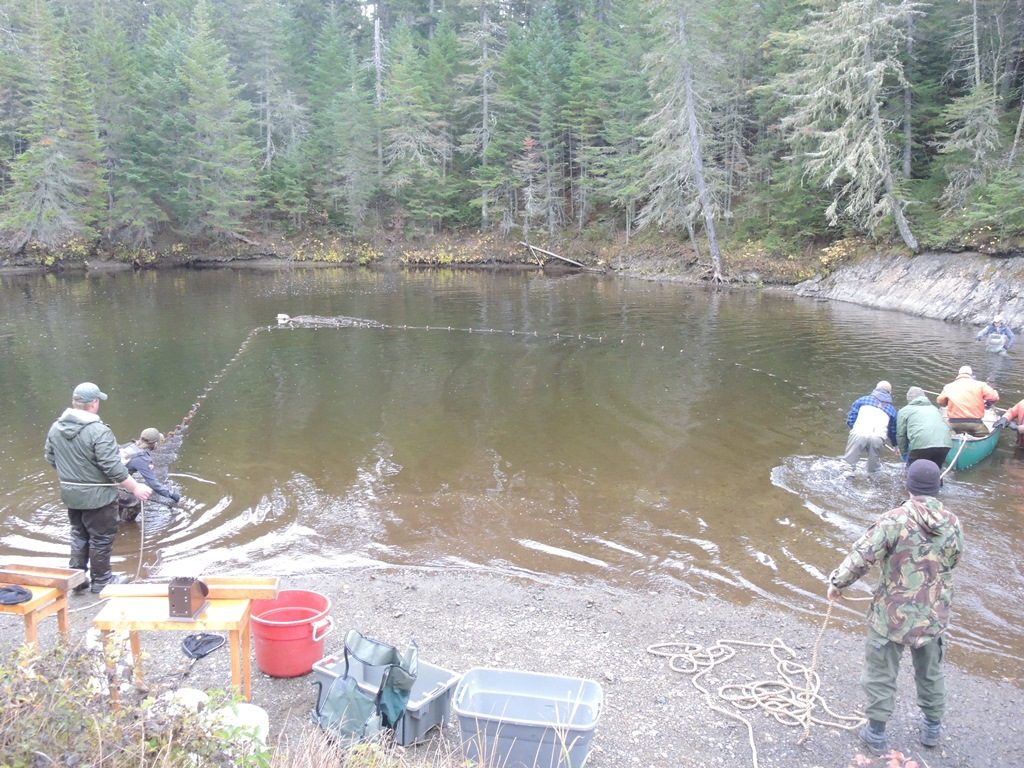 Then the loop is drawn closed so fish cannot escape.[/caption]
[caption id="attachment_2027" align="aligncenter" width="523"]
Then the loop is drawn closed so fish cannot escape.[/caption]
[caption id="attachment_2027" align="aligncenter" width="523"]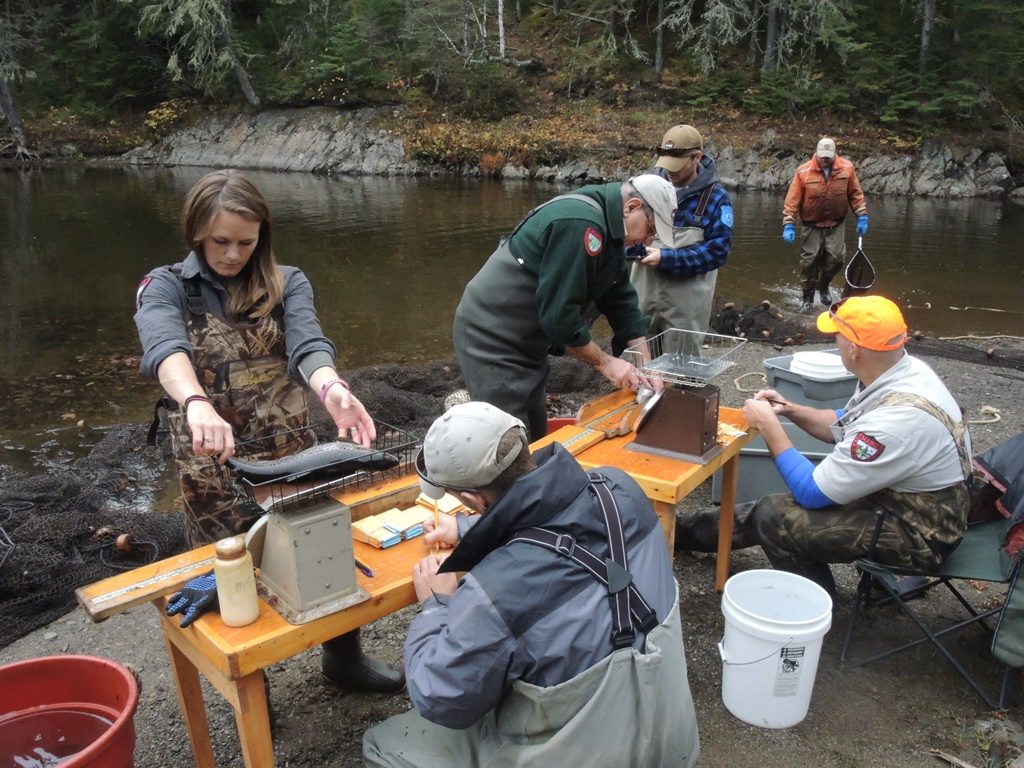 Teams weigh and measure the fish, and remove a scale in order to age the fish.[/caption]
[caption id="attachment_2035" align="aligncenter" width="452"]
Teams weigh and measure the fish, and remove a scale in order to age the fish.[/caption]
[caption id="attachment_2035" align="aligncenter" width="452"]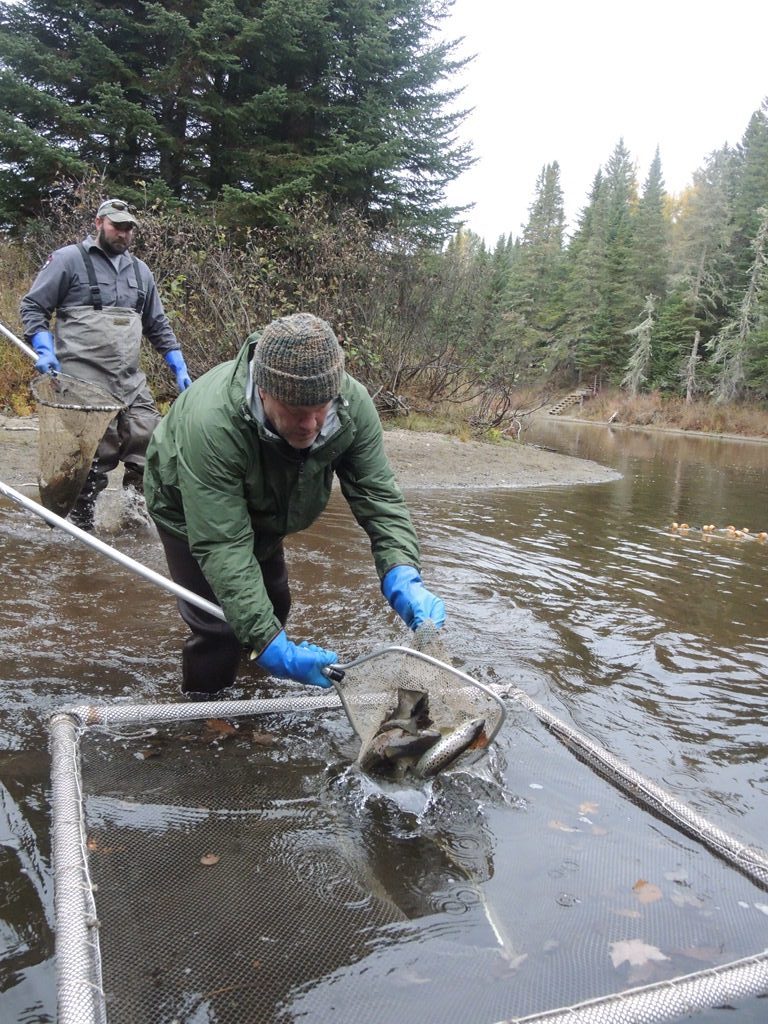 Fish are placed in a holding bin before they are examined.[/caption]
[caption id="attachment_2036" align="aligncenter" width="450"]
Fish are placed in a holding bin before they are examined.[/caption]
[caption id="attachment_2036" align="aligncenter" width="450"]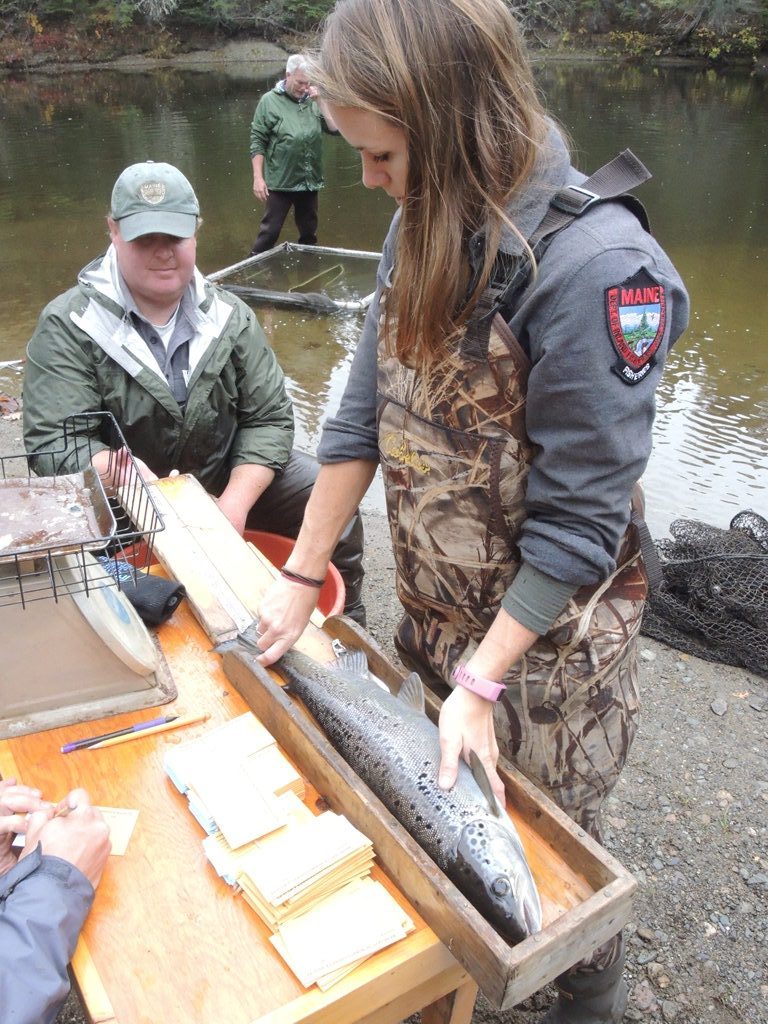 This salmon was close to 24" in length.[/caption]
This salmon was close to 24" in length.[/caption]
 Male salmon develop a kype as they prepare to spawn.[/caption]
[caption id="attachment_2020" align="alignright" width="475"]
Male salmon develop a kype as they prepare to spawn.[/caption]
[caption id="attachment_2020" align="alignright" width="475"] The net is stretched across the upriver side of steep bank pool.[/caption]
The Rangeley Region is synonymous with salmon and brook trout. Names of rivers such as the Rapid, the Magalloway and the Kennebago are instantly recognizable, and they are a welcome destination for anglers.
The Department of Inland
Fisheries and Wildlife keeps a close eye on fish populations in waterways throughout the state, including the Kennebago, which flows into Mooselookmeguntic Lake.
“The Kennebago River is the spawning area for salmon from Mooselook,” said IFW fisheries biologist Bobby Van Riper. “There is just a wealth of spawning habitat here.”
For years, the department has collected data on landlocked salmon in the Kennebago as they set to spawn.
“We evaluate the fishery each year to see if the numbers are changing, to see if there are increasing numbers of smaller fish, or more mature fish that are bigger and fatter,” said Van Riper.
In order to do this, biologists need to collect a significant number of salmon that is reflective of the population.
Steep Bank Pool on the Kennebago is well known to both anglers and salmon. The sharp 90 degree bend in the river has cut back the banks, leaving a deep hole where fish and anglers congregate.
[caption id="attachment_2021" align="alignright" width="482"]
The net is stretched across the upriver side of steep bank pool.[/caption]
The Rangeley Region is synonymous with salmon and brook trout. Names of rivers such as the Rapid, the Magalloway and the Kennebago are instantly recognizable, and they are a welcome destination for anglers.
The Department of Inland
Fisheries and Wildlife keeps a close eye on fish populations in waterways throughout the state, including the Kennebago, which flows into Mooselookmeguntic Lake.
“The Kennebago River is the spawning area for salmon from Mooselook,” said IFW fisheries biologist Bobby Van Riper. “There is just a wealth of spawning habitat here.”
For years, the department has collected data on landlocked salmon in the Kennebago as they set to spawn.
“We evaluate the fishery each year to see if the numbers are changing, to see if there are increasing numbers of smaller fish, or more mature fish that are bigger and fatter,” said Van Riper.
In order to do this, biologists need to collect a significant number of salmon that is reflective of the population.
Steep Bank Pool on the Kennebago is well known to both anglers and salmon. The sharp 90 degree bend in the river has cut back the banks, leaving a deep hole where fish and anglers congregate.
[caption id="attachment_2021" align="alignright" width="482"] And then looped along the far bank of Steep Bank Pool.[/caption]
Using a long net as a seine, biologists encircle the pool with the net, closing off the escape routes at either end of the river. After encircling the pool, the net is tightened, and the fish are collected in the belly of the net.
The fish are then moved to holding nets in deeper water, and data collection begins. Working in teams at two different stations, on person retrieves the fish from the pens, one person measures length, weighs, and collects a scale, and another records the data. It’s a well-rehearsed routine that is designed to get as much biological data as possible in short period of time.
The data collected is analyzed over the winter. Viewing the scale under a microscope reveals a salmon’s age, and that, combined with the length and the weight, is a window into the health of a salmon.
“How many fish, how old, how fat, condition of the age classes, we break the data down and it tells what is going on here,” said Van Riper
Last week, close to 80 salmon were captured and examined. The largest was just a hair over five pounds and was 24 inches in length. There were multiple salmon in excess of three pounds. While a few had hooking injuries, the vast majority did not.
All of the salmon were native fish, which is somewhat of a pleasant problem to have. The department loves to see wild salmon populations thrive, but it does present a challenge to those who manage the fishery.
When salmon are raised at the hatchery and stocked, biologists can control how many fish are placed in a lake. If salmon look thin, they can reduce the number stocked to allow the salmon population to be more in balance with the available food. With the excellent reproductive rates of the salmon in the Kennebago River, there are a lot of salmon, but biologists would like to see that population diminished a bit.
“That high salmon population puts pressure on the smelt population,” said Van Riper. “Our hope is that some anglers will keep a few more fish, which will take some pressure of the smelt population and let the remaining fish get larger.”
Anglers on Mooselook are allowed to keep three salmon, with a minimum length limit of 12 inches, but only one over 16 inches. The regulation is designed to encourage the harvest of smaller salmon, but allow an angler to keep a trophy if they wish.
In the coming years, examining the biological data from the captured salmon at Steep Bank Pool will tell biologists if it is working.
[caption id="attachment_2022" align="aligncenter" width="520"]
And then looped along the far bank of Steep Bank Pool.[/caption]
Using a long net as a seine, biologists encircle the pool with the net, closing off the escape routes at either end of the river. After encircling the pool, the net is tightened, and the fish are collected in the belly of the net.
The fish are then moved to holding nets in deeper water, and data collection begins. Working in teams at two different stations, on person retrieves the fish from the pens, one person measures length, weighs, and collects a scale, and another records the data. It’s a well-rehearsed routine that is designed to get as much biological data as possible in short period of time.
The data collected is analyzed over the winter. Viewing the scale under a microscope reveals a salmon’s age, and that, combined with the length and the weight, is a window into the health of a salmon.
“How many fish, how old, how fat, condition of the age classes, we break the data down and it tells what is going on here,” said Van Riper
Last week, close to 80 salmon were captured and examined. The largest was just a hair over five pounds and was 24 inches in length. There were multiple salmon in excess of three pounds. While a few had hooking injuries, the vast majority did not.
All of the salmon were native fish, which is somewhat of a pleasant problem to have. The department loves to see wild salmon populations thrive, but it does present a challenge to those who manage the fishery.
When salmon are raised at the hatchery and stocked, biologists can control how many fish are placed in a lake. If salmon look thin, they can reduce the number stocked to allow the salmon population to be more in balance with the available food. With the excellent reproductive rates of the salmon in the Kennebago River, there are a lot of salmon, but biologists would like to see that population diminished a bit.
“That high salmon population puts pressure on the smelt population,” said Van Riper. “Our hope is that some anglers will keep a few more fish, which will take some pressure of the smelt population and let the remaining fish get larger.”
Anglers on Mooselook are allowed to keep three salmon, with a minimum length limit of 12 inches, but only one over 16 inches. The regulation is designed to encourage the harvest of smaller salmon, but allow an angler to keep a trophy if they wish.
In the coming years, examining the biological data from the captured salmon at Steep Bank Pool will tell biologists if it is working.
[caption id="attachment_2022" align="aligncenter" width="520"] Then the loop is drawn closed so fish cannot escape.[/caption]
[caption id="attachment_2027" align="aligncenter" width="523"]
Then the loop is drawn closed so fish cannot escape.[/caption]
[caption id="attachment_2027" align="aligncenter" width="523"] Teams weigh and measure the fish, and remove a scale in order to age the fish.[/caption]
[caption id="attachment_2035" align="aligncenter" width="452"]
Teams weigh and measure the fish, and remove a scale in order to age the fish.[/caption]
[caption id="attachment_2035" align="aligncenter" width="452"] Fish are placed in a holding bin before they are examined.[/caption]
[caption id="attachment_2036" align="aligncenter" width="450"]
Fish are placed in a holding bin before they are examined.[/caption]
[caption id="attachment_2036" align="aligncenter" width="450"] This salmon was close to 24" in length.[/caption]
This salmon was close to 24" in length.[/caption]Categories